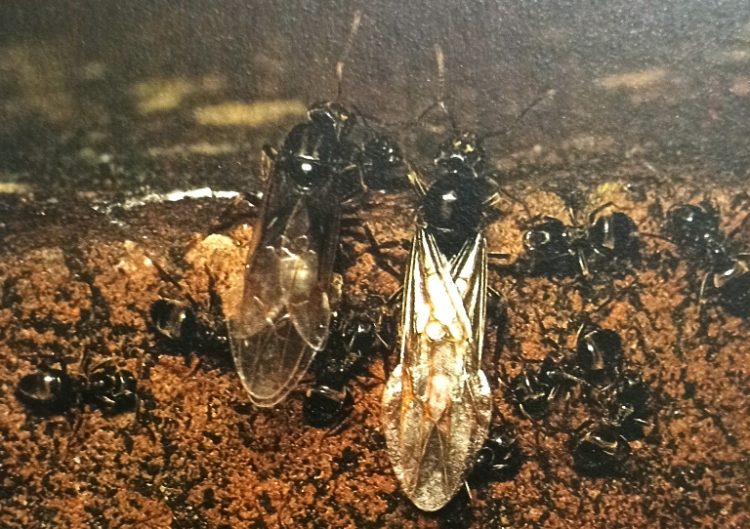Page Contents
The Black Garden Ant lifts a paving slab or turns over a large stone in the garden, and the chances are that you will find a colony of black garden ants. This species takes to the air in swarms to mate on warm, humid summer days. The black garden ant is widely distributed in the British Isles but is most common in the southern third of England.
It is a dull black, rather hairy ant and occurs in fields as well as gardens. If you look into the black garden ants’ nest at any time from late July to the end of September, you’ll find three different types of ants. The largest individuals are queens; they have four thin, transparent wings. The smallest ones-also winged-are males, while the slightly larger wingless individuals are workers. For most of the rest of the workers are they the only easily seen ants in the nest?
Mating Swarms
The black ants’ mating flight takes place in summer in warm, humid weather. Males and queens emerge from the nests in swarms- those from nests in the same neighborhood all appearing at much the same time (usually about mid-day).
They take to the air in vast numbers and then disperse. Many fall victim to predators such as swallows. Mating takes place in flight; afterward, the queens settle on the ground tear off their wings, and either return to their original nest or find a suitable place under a log or stone to overwinter. The males die soon after mating.
Colony Life
In spring the mated queen starts laying eggs. These develop into workers which build up the nest. Later in the summer new winged queens and males are produced, the males from unfertilized eggs. Life in the ant colony centers on the queen.
She is carefully tended by the workers who feed her a regurgitated sugar-rich fluid that was gathered as honeydew from aphids, or from the nectarines of flowers. The queen’s eggs are taken to special brood chambers and guarded and the larvae, when they hatch, are fed and cleaned.
Foraging
Apart from the honeydew and nectar, black garden ants eat flies and other small insects and mites, as well as crumbs dropped by people. They also gather the seeds of plants such as violets for the fat-rich body (elaiosome) they contain. Black garden ants are themselves eaten by a variety of predators.
The green woodpecker, for instance, scratches into the ants’ nest and extracts ants with its long tongue. Some ground and rove beetles, spiders, and centipedes also prey on ants, and even members of the same species attack their own kind if they come from a different nest.
Milking aphids
Ants are attracted by the sugar-rich fluid-honeydew- that is secreted by aphids. The ant ‘ milk’ an aphid by stroking its rear end with its antennae; this appears to stimulate the aphid to secrete a drop of honeydew which the ant eats and regurgitates later in the nest to feed queen or larval ants. Sometimes ants appear to protect aphids from predators by squirting formic acid.

Black garden ants (Lasius niger) swarming. The two-winged individuals are queens or males (in this picture they are too small to distinguish) which will take to the air to mate. The wingless forms are sexually underdeveloped females (workers). Read More – The Relationship between Insects and Man
